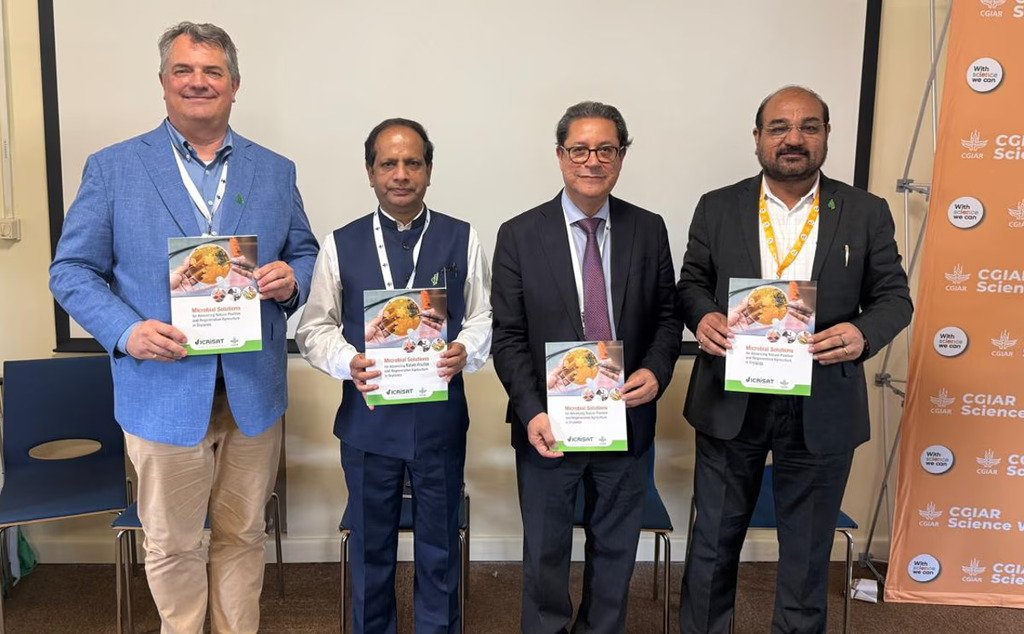In a world increasingly troubled by climate unpredictability and deteriorating land, scientists are turning their attention to something small but powerful—microorganisms in the soil. These microscopic allies, often overlooked in larger agricultural narratives, are beginning to reshape how we understand farming in drylands, where survival often hinges on resilience.
At CGIAR Science Week held in Nairobi, researchers from the International Crops Research Institute for the Semi-Arid Tropics (ICRISAT) launched a publication that brings decades of quiet research to the fore. Titled “Microbial Solutions for Advancing Nature-Positive and Regenerative Agriculture in Drylands,” the document compiles research, experiments, and real-world outcomes that place microbes at the center of soil health restoration and sustainable agriculture.
Understanding the Microbial Advantage
Microbes—ranging from bacteria to fungi—are not new to agriculture. Farmers have long known about their presence. What’s different now is the depth of understanding scientists have gained around their potential and how this potential can be harnessed intentionally. According to ICRISAT’s research, beneficial microorganisms can reduce the need for synthetic fertilizers and pesticides, restore degraded soils, and increase productivity—especially in the challenging landscapes of Asia and Africa’s drylands.
Dr. Himanshu Pathak, Director General of ICRISAT, called the publication timely, noting that microbes may be among nature’s oldest tools for building healthy soil systems. Speaking to media at the event, he stressed saying, “This publication signals a decisive move away from chemical dependency toward microbial-driven regeneration—an innovation that restores soil health, safeguards the environment, and protects human well-being. I urge all stakeholders to accelerate its adoption as a cornerstone of sustainable agriculture. “
Microorganisms in the Field: Practical Steps, Tangible Results
ICRISAT’s approach isn’t confined to theoretical science or laboratory achievements. In fact, much of the work described in the publication has already been tested and implemented across dryland farms. It includes using bacteria such as Rhizobium, Streptomyces, and Pseudomonas to improve the uptake of essential nutrients like nitrogen and phosphorus in crops such as chickpea, pigeonpea, and pearl millet.
These microbes are also being used in aerobic composting to recarbonize soil—an approach that addresses both fertility and carbon sequestration. Pest control is another area where microbes are making a difference. Microbial biopesticides are now being deployed to protect crops from threats like the cotton bollworm, a pest that has historically devastated yields.
Some of the most promising results have come in the area of micronutrient enhancement. Through a process called microbial biofortification, staple crops are being enriched with vital nutrients. This is particularly significant in regions where dietary deficiencies are common. The cumulative effect of these practices isn’t just better harvests—it’s more nutritious food on the table.
Dr. Stanford Blade, Deputy Director General of Research and Innovation at ICRISAT, highlighted this dual impact. He said, “This is not just science in the lab. It’s innovation in the hands of farmers. By working with nature instead of against it, we’re helping smallholder farmers build resilience against droughts, restore biodiversity, and grow healthier food. ”
Also Read: ICRISAT Strengthens Fight Against Aflatoxin Contamination Through Intensive Training Program
Connecting Soil to Public Health and Climate
The publication doesn’t view microbes solely through an agricultural lens. It takes a broader perspective—what experts call the “One Health” approach. This framework recognizes that soil health is intricately connected to the well-being of plants, animals, people, and the environment at large.
Dr. ML Jat, ICRISAT’s Director of Resilient Farm and Food Systems, believes that the stakes go far beyond farm boundaries. Explaining this further, he said, “Nearly 2 billion people live in dryland areas—often the first to face hunger, poor soil, and environmental decline. ICRISAT’s microbial solutions offer them a sustainable and scalable roadmap out of vulnerability, and we will continue to push the frontiers of science to deliver innovations that restore soils, secure livelihoods, and drive nature-positive development across the drylands.”
This approach is particularly urgent in drylands, which are home to nearly 2 billion people. These regions are often on the frontline of food insecurity and climate stress. For communities in these areas, microbial solutions represent more than improved yields—they could become a pathway out of recurring cycles of vulnerability.
Moving Forward with Humility and Caution
While the optimism around microbial use in agriculture is clear, the tone from ICRISAT’s scientists remains grounded. The publication emphasizes that microbes are not a silver bullet, but one part of a more balanced agricultural strategy. Their effectiveness relies heavily on local contexts—soil types, crop varieties, and weather conditions all play a role in determining outcomes.
The researchers call on stakeholders—from governments to farmers—to consider microbial approaches as foundational tools in agricultural planning. But they also acknowledge that change won’t happen overnight. Adoption will require training, awareness, and patience—qualities not often associated with the fast-paced world of agricultural innovation.
Still, the signs are encouraging. Smallholder farmers in pilot regions are already seeing improvements—not just in soil fertility, but in the consistency of their harvests and the quality of their produce. These are quiet victories, but meaningful ones.
A Soil-Centered Future
As environmental stressors intensify and the need for sustainable food production becomes ever more pressing, this new body of work invites us to rethink how solutions can be found in the smallest of places. Microbes may not command headlines like climate summits or policy reforms, but their role in supporting the life beneath our feet is gaining recognition.
By turning to these tiny organisms, ICRISAT is encouraging a form of agriculture that listens to the land instead of overriding it—an approach that could slowly, steadily shift the way drylands are farmed and how food is grown for millions.


